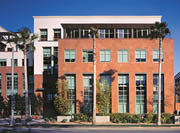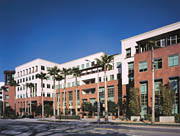

"We came to the conclusion that we would never see a million square feet of new office space built in our lifetime," said David F. Hibbert, AIA, principal of David Forbes Hibbert in Santa Monica, CA. "We went through an environmental review process and decided to add residential and retail space. We removed the hotel from the entitlement, while still allowing for some office space."
A total of 3.6 acres of the site were parceled off for 350 apartments and 2.5 for a 55,000-square-foot market. The market was only strong enough to support two office projects in the remaining space, which were named the Arboretum Courtyard and the Arboretum Gateway, according to the architect.
"There was some hesitancy as we developed a design goal," said Hibbert. "We didn¿t want to build a typical ¿80s office building with a granite exterior. We wanted to frame the buildings in concrete, allowing for greater height in the offices and larger open spaces, and there was also a desire to appeal to the entertainment industry. We wanted a softer stone with color."
The architects decided to bring in Morning Glory, a red sandstone quarried in India and supplied by Southland Stone USA, Inc. of North Hollywood, CA. "This stone was a good match," Hibbert said. "It was affordable, it hasn¿t been widely used in this area, and we could get it in the time frame we had established. The color and the warm look to it were terrific."
The architect and developer traveled to India to see the stone first-hand and meet the people responsible for quarrying it. "Going to India actually made us more nervous at first," Hibbert said. "This stone comes from the middle of nowhere. The trip was very different compared to going to Italy or France and seeing how stone is cut and containerized there. The process in India seemed rather crude, yet everything worked like clockwork. It couldn¿t have gone smoother. Their performance was better than or equal to anyone in Italy or France."

Installing the stonework
The stone was specified in a broad range of sizes and shapes, the typical piece size being 24 x 24 inches. "The architects designed a pattern in the sandstone that was made up of approximately 40 different sizes of pieces," said Kevin Robertson, director of operations at Keller Builders and project manager for the Arboretum Gateway. "It was all cut in India and crated. We had a piece-count in the thousands when it arrived onsite."The stone installation was similar to the piecing together of a giant jigsaw puzzle, according to Rob-ertson. A fluctuating crew of up to 20 people at a time from American Tile & Brick spent between two and a half to three months completing this aspect of the project.
"It was a Laticrete system," Robertson said. "The building had a Tyveck wrap on it, followed by cement board, then a Laticrete waterproofing system and Laticrete setting mastic."
According to the architect, the hardness of the sandstone eased the installation. "This sandstone is very hard, unlike the Sony building at the other end of the property," said Hibbert. "The sandstone on the Sony building was 3 1⁄2 inches thick, adding a lot of weight to the building. It didn¿t do well in the last big earthquake. The Indian sandstone we used for the Gateway was only 2 centimeters thick -- much lighter and much easier to work with. It was a positive aspect that we weren¿t aware of initially."
In addition to the sandstone, honed Jade Green slate, also supplied by Southland Stone, was specified for the base of the building. According to Robertson, the Brazilian slate was ordered in larger cubic pieces and caps. He estimates that several thousand lineal feet of slate were used for the building¿s base.
The completed building has a unique and trendy style that successfully attracted the entertainment industry to the property, according to the architect. "The look of the building had a lot to do with it getting leased in its entirety by Universal Music for its headquarters," Hibbert said. "We have gotten a lot of positive feedback on the job and won a Golden Nugget Award for the project a few months ago."
Credit Box:
Universal Music Headquarters(formerly the Arboretum Gateway)
Santa Monica, CA
Developer: Bill Hammerstein
Architect: David Forbes Hibbert, Santa Monica, CA
General Contractor: Keller Builders,
El Monte, CA
Stone Supplier: Southland Stone
USA, Inc., North Hollywood, CA
Stone Installer: American Tile & Brick, Signal Hill, CA
Installation Products: Laticrete International, Bethany, CT